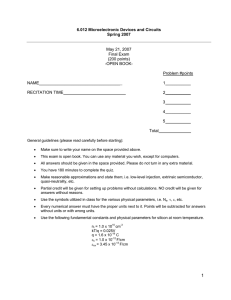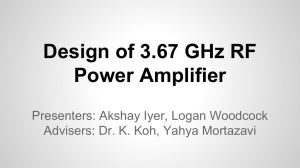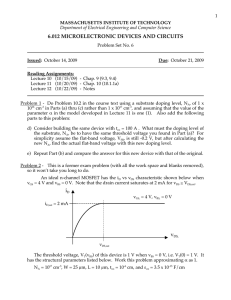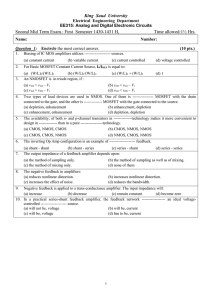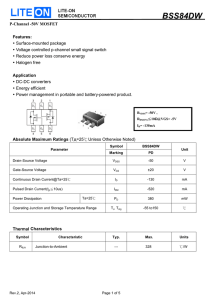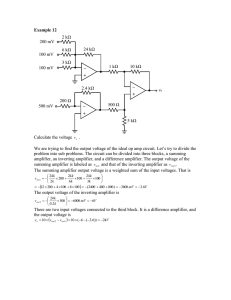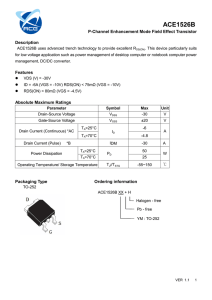6.012 Electronic Devices and Circuits
advertisement
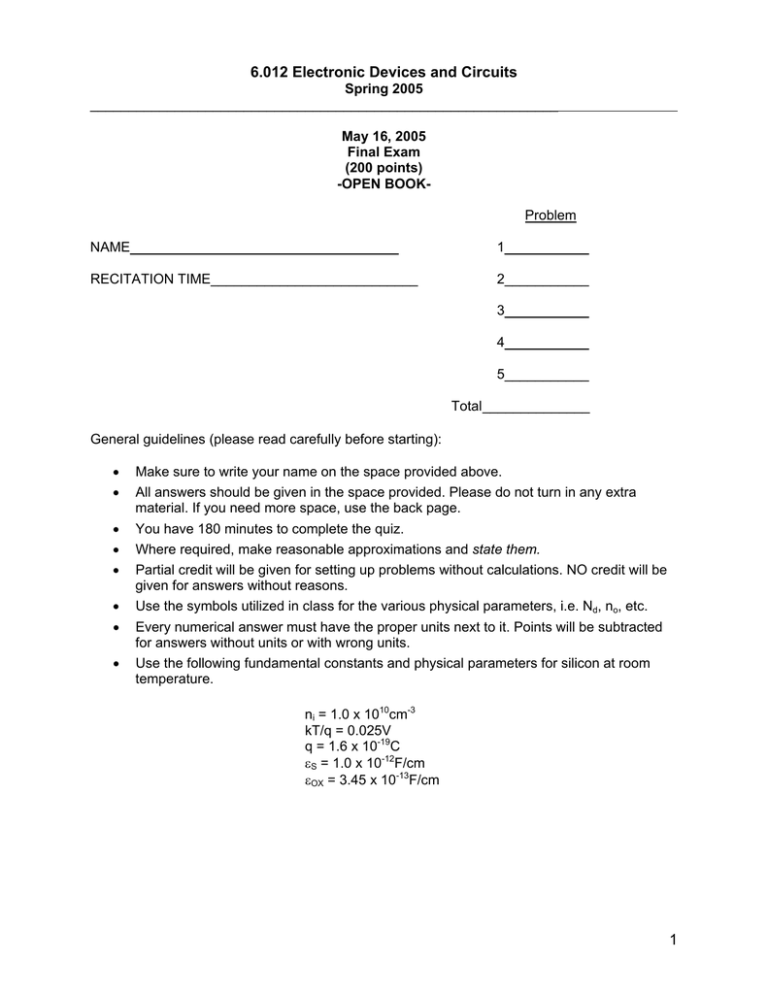
6.012 Electronic Devices and Circuits Spring 2005 _____________________________________________________________ May 16, 2005 Final Exam (200 points) -OPEN BOOK Problem NAME___________________________________ 1___________ RECITATION TIME___________________________ 2___________ 3___________ 4___________ 5___________ Total______________ General guidelines (please read carefully before starting): • Make sure to write your name on the space provided above. • All answers should be given in the space provided. Please do not turn in any extra material. If you need more space, use the back page. • You have 180 minutes to complete the quiz. • Where required, make reasonable approximations and state them. • Partial credit will be given for setting up problems without calculations. NO credit will be given for answers without reasons. • Use the symbols utilized in class for the various physical parameters, i.e. Nd, no, etc. • Every numerical answer must have the proper units next to it. Points will be subtracted for answers without units or with wrong units. • Use the following fundamental constants and physical parameters for silicon at room temperature. ni = 1.0 x 1010cm-3 kT/q = 0.025V q = 1.6 x 10-19C εS = 1.0 x 10-12F/cm εOX = 3.45 x 10-13F/cm 1 Problem 1 [40 points] An ideal n-MOSFET has transconductance, gm characteristics as shown below: gm VBS = 0V VDS = 1V VGS In addition, Cg is measured to be 0.1725pF at VDS = 0V, VGS = 3V, VBS = 0V. W = 10μm and L = 5μm. Neglect channel length modulation and neglect any overlap capacitances. Assume Na = 1017cm-3. a) On the axes below, draw the gm characteristic for VDS = 2V and VBS = 0V. Label the various regions of operation and any break-points on the plot. gm VDS = 1V VGS 2 b) Find the oxide thickness, tox. c) Find the electron mobility, μn. 3 d) On the axes below, sketch ID vs. VGS for VDS = 1V, VBS = -3.0V. Label the regions of operation of the device, and the value of ID at VGS = 3V. ID VGS 0 1 2 3 3.5 4 e) Another n-MOSFET is now fabricated with the same W, L, and Na. A new gate dielectric material is used, with dielectric constant εnew = 2 · εox, and thickness tnew = 2tox. The electron mobility for the device with the new gate dielectric is half that of a MOSFET fabricated with silicon dioxide, i.e. μnew = 1/2 μn(oxide). For each of the following, assume the same bias for each device, and circle one of the choices, giving a brief justification: i) VT for the new device, relative to the oxide-dielectric device is: lower ii) higher the same gmsat for the new MOSFET, relative to the oxide-dielectric device is: lower higher the same 5 iii) gmb for the new MOSFET, relative to the oxide-dielectric device is: lower iv) higher the same Cg for VGS = 0V and VDS = 0V for the new device, relative to the oxidedielectric device is: lower higher the same 6 Problem 2 [40 Points] A Bipolar transistor is biased to form a simple current amplifier. We are assuming no loading (RS→∞ , RL→0) as shown below: The minority carrier concentration profiles are shown on a linear scale at the DC operating point. Ae = 10μm x 10μm Dn = 10cm2/s Dp = 5cm2/s 1016cm-3 1014cm-3 0.1μm 0.2μm a) From the information given above, calculate IBIAS. 7 b) Calculate the DC collector current IC. c) Assuming the depletion capacitances, Cje and Cbc are negligible, find the frequency at which the magnitude of the current gain is unity, f = fT. 8 d) From the information given, find βo and f3dB for the Bode Plot shown below. Iout Is βo 1 f3dB fT f e) Given an input signal in the time domain fT iS(t) = 1μA COS (2π ( 10 )) t calculate the amplitude of the sinusoid at the output. 9 Problem 3 [40 Points] Consider the following amplifier circuit: Bipolar Device Data IS = 10-15A βo = 100 |VA| →∞ (ro→∞) Cπ = 200fF Cμ = 20fF Diode Device Data Io = 10-16A a) Determine VBIAS such that VOUT = 0 when VS = 0V. Assume the BJT is in the forward active region and ignore base current for this calculation. 10 b) Sketch an appropriate small signal model to determine the overall low frequency gain including RL. c) Calculate the overall low frequency voltage gain using the model you sketched in part (b). State any simplifying assumptions. 11 d) Sketch a small signal model that includes Cπand Cμ. e) Using the Miller Theorem, calculate the Miller capacitance numerical value. 12 Problem 4 [40 Points] You are given a CS amplifier driving a purely capacitive load as shown below with the NMOS and PMOS device data. Assume all transistors are in the saturated region and assume all sources are shorted to the backgate. Device Data Vtn = 0.5V Vtp = -0.5V μnCox = 50μA/V2 μpCox = 25μA/V2 For W/L = 150/1.5 Cgd = 150fF Cgs = 350fF Neglect channel length modulation for part a & b. a) Calculate the value of I to make the p-channel supply current source for the CS amplifier have a value of 100μA. 13 b) Calculate VBIAS such that the NMOS drain current is equal to ISUP = 100 μA. c) Calculate the transconductance of the CS amplifier at the operating point set in a & b. 14 d) Given that the low frequency voltage gain is –50, calculate Rout and (λn +λp). Do not assume any particular λ. e) A two-port model for the CS amplifier with capacitors added is shown below. Using the Miller Theorem and Method of Open Circuit Time Constants, find ω3dB. 15 f) The width of the p-channel supply current source in the CS amplifier is reduced from 150μm to 1.5μm and the reference current source value remains I. Estimate the new low frequency voltage gain. g) Estimate the new ω3dB with the smaller (1.5μm) p-channel current source. State assumptions to reduce the amount of work you do for this part. 16 Problem 5 [40 Points] You are given a multistage voltage amplifier shown below. Assume that all devices are in their constant current region (MOS-saturated, BJT-forward active), at the operating point set by VBIAS. Assume all substrates are shorted to their source. Device Data + RL vout - VTp = -0.5 μpCox = 25μA/V2 λP = 0 ßo = 100 VA = 10V a) Identify the type of stage (e.g. CS, CD) and the numerical value of the supply current sources for stages 1 and 2. 17 b) A small signal two-port model of both stages including RS and RL is shown below. Calculate Rin1, Av1, and Rout1 vs 18 c) Calculate Rin2, Av2, and Rout2. d) Given RS = 20kΩ, adjust the width of the p-channel stage 1 supply current source such that 50% of the voltage enters the amplifier. 19 e) Given RL = 500Ω adjust the width of the p-channel stage 2 supply current source such that 50% of the voltage is transferred to the load. f) What is the overall voltage gain vout/vs [assuming the p-channel current sources are sized as in (d) and (e) above]? 20 MIT OpenCourseWare http://ocw.mit.edu 6.012 Microelectronic Devices and Circuits Spring 2009 For information about citing these materials or our Terms of Use, visit: http://ocw.mit.edu/terms.
